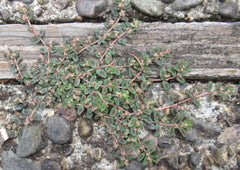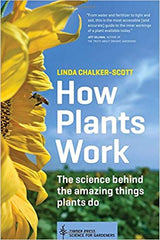With our world in such an unusual condition now, I find the plant world a sane and stable refuge. My garden is a stress-reliever in the best of times, and it is a special help to me now. With our unusually cool and moist weather last month (Is anything usual?), the plants have done well. There was a bumper crop of cherries, and my flowers have been blooming enthusiastically since early spring.
The weeds have also done quite well. Weeds are a good source of material for botany lessons, and they are found all over, in city sidewalk cracks as well as gardens. Their adaptations make them very abundant. There are few problems with uprooting them and dissecting them. It is a good thing to learn your local weeds and know some of the lessons they offer.
First, perhaps I’d better say what I mean by a weed. It is plant that grows where it is not wanted and displaces or damages the plants I want to grow. In my garden, some violets are weeds because they spread all over. The one below is especially weedy.

Weeding is applied leaf shape work. Learning to recognize the local weeds is a great gardening skill for children or adults. First, children have to recognize the leaves of desirable and undesirable plants. It takes time to carefully observe the garden, and it is important to have a guiding adult’s help to learn what to keep and what to uproot.
I don’t mean that children have to give the weed’s leaf shape a formal name. Many leaves can be recognized by overall appearance, and noting the leaf’s traits, such as lobes, teeth, or a particular surface texture, can help one identify the plant. Whether the leaves are opposite, alternate, or whorled around the stem is also an important trait, as is the overall size and shape of the plant.
Weeds helps hone one’s observation skills. One key to being a great weed is to escape detection for as long as possible. If your children want to find weeds to study, they will have to look carefully. The spotted spurge is a champion at hiding. The dark markings on its leaves make it hard to see against the soil, and it is a prostrate plant, one that grows very flat against the soil. The overall look of this plant, its milky white sap, and its leaves are a good way to recognize it. Warn children that the sap is very irritating, which brings up another reason to know your weeds – learn the hazards that children may encounter handling them. They will need gloves if they are pulling or digging spurges.

Every spring, I pull the dozens of little maple seedlings, which I recognize by their toothed, opposite leaves. There isn’t enough room for them to grow where they have sprouted. The oak seedlings from acorns that jays and squirrels planted sprout leaves that may not look like a mature oak (see below). I want to pull the little oaks quickly before they grow deep roots and are harder to remove so I need to look for their young leaves.

Weed roots can provide interesting material for study, particularly if you can extract most of the root system. Here is a blackberry seedling that I pulled from soft soil. I was impressed by the length of its tap root. Note the transition from the stem to the roots. To make sure the weed doesn’t grow back, you have to get all the stem and the upper portion of the roots. If the top of the root remains in the soil, it can grow new shoots.

If you pull up a red-root pigweed, you’ll recognize it. It is a member of the notoriously weedy amaranth family. The plants are capable of making thousands of tiny seeds.

You can make illustrations to help children recognize weeds by photographing the plant or by placing a specimen that you have collected between two acetate sheets and scanning it or photocopying it. The acetate will help keep the scanner or copier clean.
A field guide to weeds is a great help for identifying them. There is the excellent Lone Pine Guide, Weeds of Canada and the Northern United States for those regions. In the Midwest and Rocky Mountain regions of the US, Weeds of the West, published by the University of Wyoming, is very useful. Northwest Weeds by Ronald J. Taylor is a helpful guide for that area of the US. If you are in the western US, the children’s book, Outlaw Weeds of the West by Karen M. Sackett, is a good resource for learning about weeds and their adaptations. If these do not cover your area, look for a local weed guide.
Have fun getting down in the weeds!
Last time, I wrote about the Montessori material called “Botany Impressionistic Charts.” I’ve looked at the meaning of the work “impressionistic,” and the only definition that seems to be relevant to the charts is “overview.” If I ever produce a version of this material, I will call it “An Overview of How Plants Work.”
In my previous article, I addressed the needs of plants, including the one so often omitted, the need for oxygen. This time, I’m looking at roots. Well, not literally looking at them other than on the weeds I’ve been pulling, but I’m reading about them.
Roots on the traditional charts are rather simple. They anchor the plant in the soil, take in water, and prevent soil erosion. This makes them seem about as interesting as tent stakes and drinking straws. There is a lot more to roots. I recently acquired a book called The Nature of Plants: an introduction to how plants work. The author, Craig N. Huegel, states “Roots may well be the most important plant organ and the least understood.”

Roots are a last frontier for botany for good reason. They are hidden in the ground, and any attempt to see them disturbs them. In the past few years, there have been attempts to image root growth with MRI, CAT scans, and optical scanners in a tube that is buried in the ground amid the roots. Botanists are realizing that understanding roots is very important, both for the health of the plant and the planet. The ability of a plant to take up carbon dioxide depends on its roots.
There are some items of misinformation on the traditional “Botany Impressionistic Charts.”
- Roots grow only to the drip line of the foliage. Wrong! If you have ever weeded a garden or dug up plants, you’ll know this one is a myth. At least in all but the most mature trees, the feeder roots extend about 2-3 times the diameter of the canopy according to Morton Arboretum, Colorado State University Extension, and other reliable sources. The root spread of herbaceous plants varies tremendously depending on species and environment, but I have seen many root maps of herbaceous plants that show roots extending well beyond the diameter of the foliage.
- As a result of the spread of roots, the leaves of the plant do not direct rainwater within the dripline because the roots end there. In fact, I found only one example of leaves sending rainwater to roots, and that was desert rhubarb from Israel.
- Roots seek water. This happens, but not like it is usually illustrated. Most of a tree’s roots grow in the top 6-24 inches (15-60 cm) of the soil. These laterals are the primary water absorbers. There aren’t many larger deep roots, and these don’t turn and head off to distant water. Hydrotropism occurs over millimeter distances, not meters. The part of the root that turns is the root cap, which means only the tip end of the root changes course. Botanists describe root foraging, in which roots grow out from the plant all directions and give rise to many small branches when they encounter pockets of water or minerals that they need. This would be a better picture to give children.
Useful concepts illustrated on the charts include:
- Roots hold the soil. This is certainly an important function of roots. Another chart could go beyond this and show that roots improve the soil as well. They make channels in the soil and excrete substances that cause soil particles to clump. This helps water and oxygen penetrate the soil. They also excrete substances that help the plant solubilize and gather nutrients such as phosphorus and iron. These exudates feed the helpful soil bacteria near the roots as well.
- Roots grow around obstacles. They seem to feel their way around the obstacle until their path is open.
Here are other important ideas about roots that are not illustrated on most sets of botany impressionistic charts.
- The first root of young plants grows down and the shoot grows up (gravitropism). (Soon after the primary root forms, the lateral roots grow from it. In most monocots, the primary root is short-lived, and many adventitious roots grow from the base of the stem.)
- Roots store the extra food that the leaves make. This is easy to see in a root like a carrot or beet, but even slender roots store food.
- Roots have feeding partnerships with fungi (mycorrhizae) and bacteria. These microbial partners also help defend the root from harmful microorganisms. The majority of plants relies on mycorrhizae and grows poorly or not at all without them. Children need to know about this, the most wide-spread symbiosis on Earth.
- Roots can be adapted to serve other functions. Examples include prop roots, climbing roots, parasitic roots (haustoria), and pneumatophores.
I encourage you to give children an accurate, exciting view of roots. There is plenty of mystery and discoveries to be made about the root system. Here is another book that can help you, How Plants Work: The science behind the amazing things plant do by Linda Chalker-Scott.

Happy botany studies!
Priscilla







